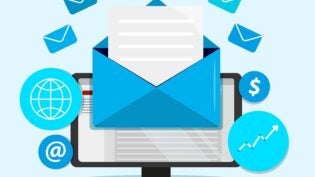3 Reasons Marketing Disruption Will Work for Your Business to Build Your Brand
By: Redshift

Technology is changing everything, from manufacturing and construction to design and engineering—and it’s changing at what feels like a rapidly increasing pace. As a professional in one of those industries, you know this all too well.
From the tools to design, build, and make things to the demands of customers, today’s business landscape is nothing like that of 15 or 20 years ago. Every day, I share with customers how Autodesk products and technologies can make these transitions easier and more efficient. But even as I’ve been having these conversations, I have started building empathy with these customers.
That’s because I’m going through these rapid disruptions, too.
Seismic shifts are happening in marketing. My field isn’t immune to the forces that are pushing manufacturing and construction toward more technology and innovation: Big data, machine learning, and cloud computing are upending decades-old marketing practices. Like you, part of my everyday job is to stay ahead of these changes.
The examples below show how marketing is evolving, the challenges these disruptions pose, and the opportunities you have to move your company’s brand forward using new technologies.
1. The Means of Marketing Are Changing
You can’t separate the tools of a job from the practice of a job. A surgeon and a scalpel make a powerful combination, but separated, they can accomplish very little. Likewise, marketers can’t market today without automation. It’s true that automation is making marketing more efficient and more productive—those are benefits, but they’re not the disruptive force. That’s simply how marketing is done today.
Instead, I think the real disruption is going to happen with machine learning. The computer, instead of just automating elements of marketing, will soon be another marketer in the room—one with vast data storage and computing capabilities.
Take the idea of generative design. It’s a creative approach that uses cloud-computing power to output myriad design possibilities based on specific conditions or parameters. In a way, it mimics nature’s evolution: The strongest elements stay; the weaker ones disappear. Generative design for marketing will be able to process the historical results of past campaigns, apply them to the business objectives of a new campaign, and create the best play for you. This type of technology can produce things your marketing team may not have thought of because people don’t have the complete historical data and recall ability the computer has.
Here’s the part that makes marketers uncomfortable: This automation will upend elements of marketing many have been doing for decades—that is, making decisions. But while these tools take the more boring, rote work out of marketing, they allow humans to do more intellectually stimulating work. These are the things the computers can’t do: the creativity, the relationship building, the empathy. You can’t automate that.
So instead of dreading the coming automation, be excited because it provides an opportunity to truly invest in the key human areas of marketing while the machines do the computing.
2. Quality of Data Is More Important Than Quantity
Data is the currency of the 21st-century marketer. Marketing automation is useless if you don’t have good, clean, relevant, and quality data. Even the simplest data sets, like email lists, are only as good as the quality of the content and the tools you use to process it. But with the mountains of data come the requirements to translate it, interpret it, and put it to meaningful use—and in a way that is respectful of clients and prospects and their intentions.
To some extent, customers expect you to collect data on them, and they expect to be retargeted. It’s marketers’ job to use this data in a way that builds a relationship between the customer and the brand. If the marketing tactic is intrusive and irritating, it’s a solicitation. Use such tactics repeatedly, and you’ll fall out of favor with that customer or prospect. But if your message is relevant and engaging, it’s a connection, an opportunity to feel understood and validated.
However, instead of finding interesting data tools and applying your information to the tool’s capabilities, flip the process on its head. Ask yourself, “What am I trying to achieve with this data?” Then, go find the technology that allows you to use that data in the most competitive, differentiated way.
3. Customers Want Stories, Not Sales Pitches
Marketers know that content production is being disrupted on several fronts. How and where people consume content is different than just a handful of years ago. Tablets, phones, and watches can deliver targeted content at your fingertips. Podcasts and immersive digital experiences are disrupting the way marketing is delivered, too.
But this vast content landscape doesn’t mean marketers have to produce something on every platform. In fact, you shouldn’t employ the strategy of throwing everything at the proverbial wall and seeing what sticks. Instead, you should seek to produce something that rises above the tsunami of content.
So how do marketers do that? Storytelling.
Storytelling is a means to capture and hold somebody’s attention. It’s how you differentiate your brand, and I think it’s absolutely critical for companies today. Storytelling is how you create an affinity for your brand. It’s one thing for a customer to understand what your company does or stands for. It’s another for that customer to say, “I have an emotional attachment to what this company does because it speaks to what’s most important to me.”
The practice of storytelling comes in many forms, from old standbys like success stories and videos to newer platforms such as virtual reality (VR). Steelcase recognized the potential in combining VR and gaming technology to create a sales and marketing tool called the Virtual Office Space. Customers can don a pair of VR goggles and feel what it’s like to walk through a redesigned office space outfitted with all manner of Steelcase furniture.
One way that Autodesk tells its story is through the Autodesk Gallery in San Francisco. There, visitors can walk up to and experience physical examples of the incredible work our customers produce, and one of the most popular times to visit the Gallery is during Design Night. These immersive digital and live experiences are gaining enough traction that soon they will be expected—especially for Generation Z and beyond.
It’s a good thing for customers to have marketing expectations. They can recognize bad marketing tactics, which means they expect good ones from you. They expect your interactions with them to be personalized. You should know, for example, that they’ve been searching on, say, “site-execution automation software for construction,” “better scheduling tools,” or “the convergence of construction and manufacturing.” And because you should know that, you should be delivering relevant, helpful, engaging content that meets those specific information needs.
What all of this means is that, rather than fear disruption, today’s marketers should embrace the tools and innovations that help you best serve the needs of your customers and prospects. Use those tools to understand who your customers are and what they want so you can deliver quality, affinity-building content that meets their needs—and solidifies their relationship with your brand.














